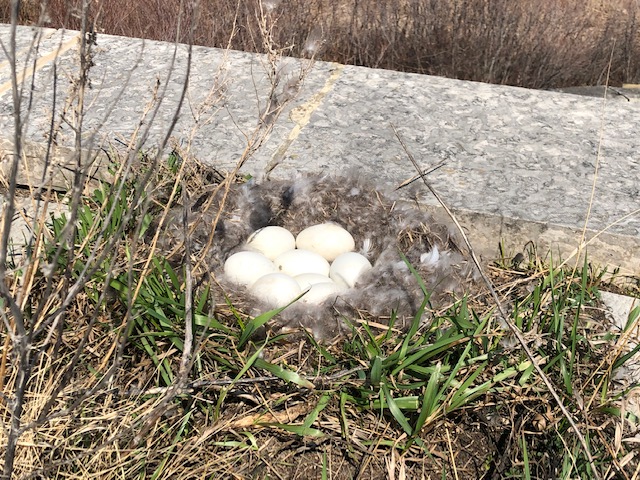Type and press “enter” to search
The Canada goose pair arrived at Oak Hammock Marsh in early March, just as the frozen wetlands were starting to soften and thaw. Together, they weathered a spring snowstorm, heavy rains, and the ever-blowing prairie winds. As the temperatures warmed, the female scouted the perfect location for her nest—one that gave her an ideal vantage point to scan the surroundings for predators, and one set into clumps of native grasses to provide cover and camouflage.
Their chosen location? The roof of DUC’s national offices and Oak Hammock Marsh Interpretive Centre.
They (well, her, mostly) dragged dried grasses and other plant materials to this site to build their nest, which the female lined with down and body feathers. About the second week of April, she laid eight eggs into this soft hollow. Now, the mother goose sits on her brood-to-be and waits. And so do we.
The goose isn’t aware that for the next week she’ll be an Internet celebrity. Hundreds of people will be tuning in to watch her progress 
Nest with eggs
With the Interpretive Centre temporarily closed to the public during the COVID-19 pandemic, “this is the perfect opportunity for people to watch nature in action at the marsh, from the safety and comfort of home,” says Jacques Bourgeois, communications and marketing coordinator, Oak Hammock Marsh Interpretive Centre.
The Canada goose pair likely chose the site because they themselves may have hatched at the marsh, says Bourgeois. “Canada geese mate for life, so it could also be a pair who have returned year after year to successfully raise their goslings,” he adds.
Either way, they couldn’t have picked a better place to wait out the 25 to 28-day egg incubation period. It’s an award-winning one. The Oak Hammock Marsh Interpretive Centre Green Roof is Manitoba’s first and largest green roof. Ninety-eight per cent of the roof is planted with prairie wildflowers and native grasses.
According to Bourgeois, this is one of three pairs of geese who decided to setup their nest on the rooftop. They are a subspecies called the Giant Canada Geese (Brenta canadensis maxima).
Several other bird species will take up residence on the green roof every year including mallards and killdeers. Building the nest on the rooftop means that it will be protected from natural predators such as racoons, skunks, foxes and coyotes. Avian predators such as gulls, magpies, crows and ravens are a threat from above, but Canada geese are extremely devoted and protective parents.